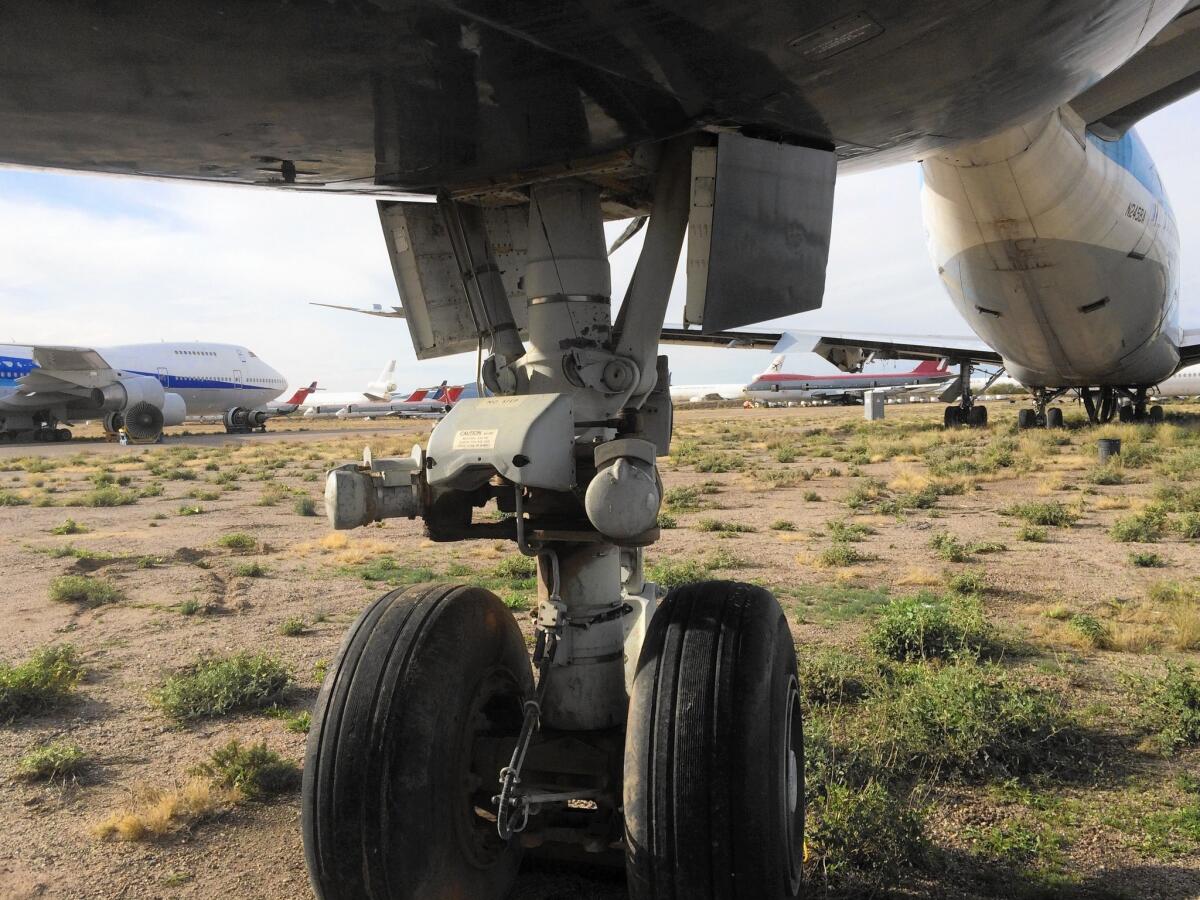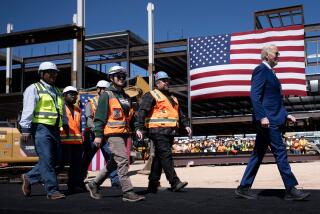Arizona’s Pinal Airpark serves as airport, graveyard, junkyard, museum

- Share via
Reporting from Marana, Ariz. — The first thing you notice about Pinal Airpark is the noise: There isn’t any.
More than 120 massive airplanes — most outfitted with engines that, when revved, could make your teeth ache from half a mile away — are splayed on both sides of the airport’s 6,800-foot runway. Yet the place is so quiet you could hear a rattlesnake approach.
The shah of Iran’s private jet spent its last days here, parked next to aircraft the CIA used for covert missions in Southeast Asia and Central America.
Hulking jumbo jets that once ferried the rich and famous around the world in luxury now sit alongside tiny two-engine planes that were barely airworthy on their final flights for bankrupt Third World carriers.
They are all equal in death, however. And most of these planes have come to the desert outside Tucson to die.
“A lot of these, they’ll never fly again,” said Jim Petty, a pilot as well as the airport’s economic development director.
Pinal Airpark is a boneyard for civilian aircraft, one of several scattered across the arid Southwest, where the dry climate prevents corrosion. That allows planes stored for years to be returned to service should a need arise.
Not that it arises often. More commonly the aircraft are salvaged for spare parts, perhaps stabilizer flaps and landing gear. The big money, though, will continue to come from storing, then destroying, the old airplanes Petty has grown to love.
With aircraft construction moving from aluminum to carbon fiber, which is lighter and stronger, the planes from the 1960s, ‘70s and ‘80s that cover the airfield are anachronisms, like typewriters in the computer age. But because 90% of an airplane is recyclable, they are valuable as scrap.
Once the planes have been stripped, a backhoe outfitted with a claw-like device rips the fuselage apart. A plane that took months to build can be shredded in hours, its aluminum then trucked into town to be recycled.
“And the amount of planes that are going to be taken out of service and recycled is more than it’s probably ever been before in the history of aviation,” Petty said.
Many of the abandoned aircraft — Airbus A300s, Boeing 747s and 767s, McDonnell Douglas MD-80s — still carry the distinctive paint schemes of the companies that flew them — Mexicana and China Southern, TWA and DHL. Across the taxiway are detritus from smaller airlines, such as Balkan Holiday, Turkmenistan Airlines and Air Madagascar.
Some belong to the airlines whose logos they bear, while other airlines pretend their planes aren’t here at all, prohibiting photographs of them (you know who are, Delta). And still others are kept here by leasing companies, which try to resell them before giving up and cannibalizing them for parts.
“Every plane out there has a different story — who owns it, why it’s there, what they’re going to do with it,” Petty said.
Petty stopped his white crew-cab pickup on a taxiway behind a 747. The plane stands naked without its jet engines, which lie on the ground nearby. Across the way a couple of planes rest on piles of stacked railroad ties, their landing gear having been ripped out and resold. On many the interiors are empty, the seats having been removed long ago. Others are nearly pristine inside, as if waiting for the passengers to board.
“Depending on why it’s in storage, it might have a happy ending or a sad ending,” Petty said.
After years of benign neglect, the 1,500-acre air park faces the same kind of uncertain future.
Opened in 1943 as Marana Army Air Field, the airport was used as a training base during World War II. When the government began giving away its military airfields after the war, it deeded the property to Pinal County, which in turn leased the facilities and most of the airport’s operations to various tenants, including the CIA.
Here Petty’s voice dropped to a whisper as he recounted rumors of a front company used to disguise black-ops missions into Vietnam, Tibet and Bangladesh in the 1950s and ‘60s and a daring mission to retrieve two agents from an abandoned Soviet base in the Arctic.
Reminders of the facility’s secret past are everywhere, beginning with the abandoned guard shack at the end of the narrow two-lane road leading into the air park. Weathered signs still shout “No admittance” and “Authorized personnel only.”
The site hasn’t completely abandoned its military past. Just past the north end of the runway the Army National Guard has a training site, principally to teach pilots how to operate the Apache attack helicopter. It is also home to the U.S. Special Operations Command’s parachute training facility, which plays host to elite units, such as the Navy’s SEAL Team 6.
But, Petty said, most of that happens on the other side of the fence now. For Pinal County, which took over day-to-day operations of the air park last January, the focus is on improving the facility and making it an economic engine that provides jobs and revenue for the area.
“It’s in pretty rough shape,” Petty said of the airport. “And it’s hasn’t been cared for too well lately. So we’re hoping to turn that around.”
The airport still handles civilian air traffic, although the runway needs repaving, a project scheduled to begin shortly. And some of the lightning equipment, which dates to the 1950s, must be replaced.
Petty hopes to fund some of that work by opening the air park to moviemakers and aviation buffs. One guy spent more than $6,000 to rip out 38 seats and buy a few drink carts to decorate his factory.
But Petty the pilot admits he too pays a price for each of those sales.
“It makes me sad to see these planes all broken down like this,” he said.
More to Read
Sign up for Essential California
The most important California stories and recommendations in your inbox every morning.
You may occasionally receive promotional content from the Los Angeles Times.













